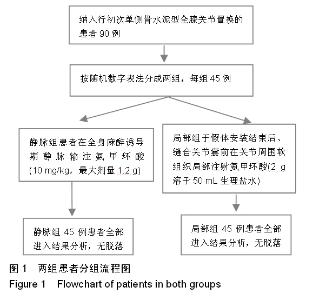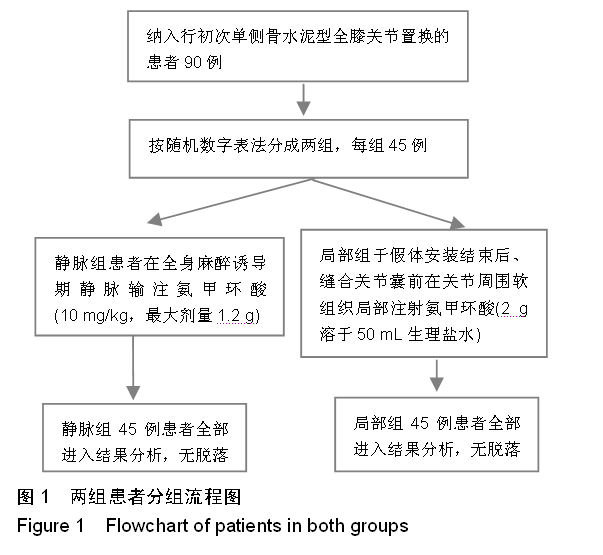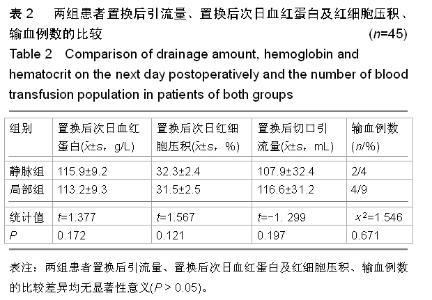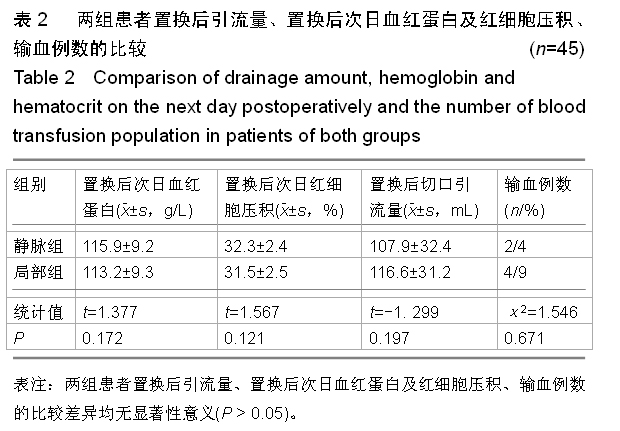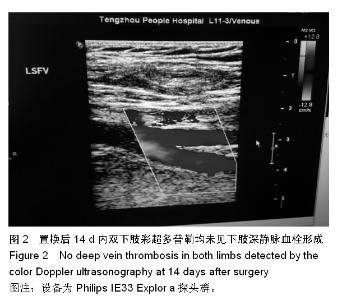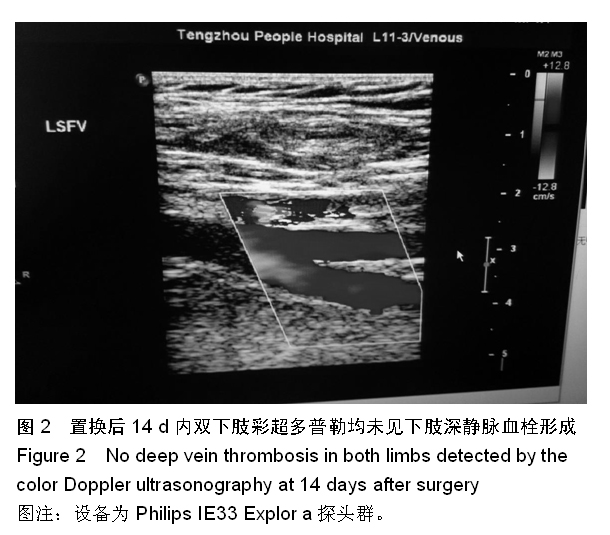Chinese Journal of Tissue Engineering Research ›› 2015, Vol. 19 ›› Issue (35): 5604-5609.doi: 10.3969/j.issn.2095-4344.2015.35.006
Previous Articles Next Articles
Effects of intravenous versus topical application of tranexamic acid on blood loss following total knee arthroplasty
Chai Xing-yu1, Su Chang-zheng1, Pang Tao1, Lv Dong1, Zhu Biao1, Hou Zhen-yang1, Li Zhen1, Xu Zheng-wen1, Zhao Ting-bao2
- 1Second Department of Joint Sports Medicine, Tengzhou Central People’s Hospital,Tengzhou 277500, Shandong Province, China; 2Department of Spinal Cord Repair, Jinan Military General Hospital, Jinan 250031, Shandong Province, China
-
Received:2015-06-24Online:2015-08-27Published:2015-08-27 -
Contact:Zhao Ting-bao, M.D., Chief physician, Department of Spinal Cord Repair, Jinan Military General Hospital, Jinan 250031, Shandong Province, China -
About author:Chai Xing-yu, Master, Physician, Second Department of Joint Sports Medicine, Tengzhou Central People’s Hospital,Tengzhou 277500, Shandong Province, China
CLC Number:
Cite this article
Chai Xing-yu, Su Chang-zheng, Pang Tao, Lv Dong, Zhu Biao, Hou Zhen-yang, Li Zhen, Xu Zheng-wen, Zhao Ting-bao. Effects of intravenous versus topical application of tranexamic acid on blood loss following total knee arthroplasty[J]. Chinese Journal of Tissue Engineering Research, 2015, 19(35): 5604-5609.
share this article
| [1] 赵星晾,李子剑,张克.氨甲环酸在人工全膝关节置换术中的应用[J].中华关节外科杂志(电子版),2014,8(2):236-239. [2] Lemaire R. Strategies for blood management in orthopaedic and trauma surgery. J Bone Joint Surg Br. 2008;90(9):1128- 1136. [3] Good L, Peterson E, Lisander B. Tranexamic acid decreases extermal blood loss but not hidden blood loss intotal knee replacement. Br J Anaesth. 2003;90(5):596-599. [4] Sehat KR, Evans R. Newman JH. How much blood is really lost in total knee arthroplasty? Correct blood lossmanagement should take hidden loss into account. Knee. 2000;7(3):151-155. [5] Hippala ST, Stird LJ, Wennerstrand MI, et al. Tranesamic acid radically decreases blood loss and trandfusions associated with tatal knee arthroplasty. Anesth Analg.1997;84(4): 839-844. [6] Jansen AJ, Andreica S, Claeys M, et al. Use of tranexamic acid for an effective blood conservation strategy after total knee arthropalsty. Br J Anaesth. 1999;83(4):596-601. [7] Benoni G, Fredin H, Knebel R, et al. Blood conservation with tranexamic acid in total hip arthroplasty: A randomized, double-blind study in 40 primary operations. Acta Orthopaedica. 2001;72(5):442-448. [8] Fiebig E. Safety of the blood supply. Clin Orthop Relat Res. 1998;357:6-18. [9] Tobias JD. Strategies for minimizing blood loss in orthopedic surgery. Semin Hematol. 2004;41(1 Suppl):S145-156. [10] Sabatini L, Trecci A, Imarisio D, et al. Fibrin tissue dhesive reduces postoperative blood loss in total knee arthroplasty. J Orthop Traumatol. 2012;13(3):145-151. [11] Maniar RN, Kumar G, Singhi T, et al. Most effective regimen of tranexamic acid in knee arthroplasty:a prospective randomized controlled study in 240 patients. Clin Orthop Relat Res. 2012;470:2605. [12] Sabatini L, Atzori F, Revello S, et al. Intravenous use of tranexamic acid reduces postoperative blood loss in total knee arthroplasty. Arch Orthop Trauma Surg. 2014;134: 1609-1614. [13] Hawi N, Kendoff DO, Hessling U, et al. Effectiveness of an autologous transfusion system following cemented and non-cemented revisions of total hip arthroplasty. Int Orthop. 2014;38(8):1603. [14] Horstmann WG, Swierstra MJ, Ohanis D, et al. Favourable results of a new intraoperative and postoperative filtered autologous blood re-transfusion system in total hip arthroplasty: a randomised controlled trial. Int Orthop.2014; 38(1):13. [15] Gandhi R, Evans HM, Mahomed SR, et al. Tranexamic acid and the reduction of blood loss in total knee and hip arthroplasty: a meta-analysis. BMC Res Notes. 2013;6(1): 184. [16] MacGillivray RG, Tarabichi SB, Hawari MF, et al. Tranexamic acid to reduce blood loss after bilateral total knee arthroplasty a prospective, randomized double blind study. J Arthroplasty. 2011;26(1):24-28. [17] Karam JA, Bloomfield MR, Dilorio TM, et al. Evaluation of the efficacy and safety of tranexamic acid for reducing blood loss in bilateral total knee arthroplasty. J Arthroplasty. 2014;29(3): 501-503. [18] Iwai T, Tsuji S, Tomita T, et al. Repeat-dose intravenous tranexamic acid further decreases blood loss in total knee arthroplasty. Int Orthop. 2013;37(3): 441-445. [19] Gandhi R, Evans HM, Mahomed SR, et al. Tranexamic acid and the reduction of blood loss in total knee and hip arthroplasty: a meta-analysis. BMC Res Notes. 2013;6(1): 184. [20] Gillette BP, DeSimone LJ, Trousdale RT, et al. Low risk of thromboembolic complications with tranexamic acid after primary total hip and knee arthroplasty. Clin Orthop Relat Res 2013;471(1):150. [21] Aguilera X, Martinez-Zapata MJ, Bosch A. Efficacy and safety of fibrin glue and tranexamic Acid to prevent postoperative blood loss in total knee arthroplasty: a randomized controlled clinical trial. J Bone Joint Surg. 2013;95(22):2001-2007. [22] Ma YO, Zhang YC, Zhang H. [Local application of tranexamic acid reduces blood less in unilateral total knee arthroplasty: a retrospective comparason analysis]. Zhonghua Waike Zazhi. 2013;51(1):40-43. [23] Vigna-Taglianti F, Basso L, Rolfo P, et al. Tranexamic acid for reducing blood transfusions in arthroplasty interventions: a cost-effective practice. Eur J Orthop Surg Traumatol. 2014; 24(4):545-551. [24] 闵鹏,彭银虓,胡江海,等. 氨甲环酸对单侧全膝关节置换失血量的影响及安全性评价[J].中国组织工程研究,2015,19(17):2655-2660. [25] 邱贵兴.中国骨科大手术静脉血栓栓塞症预防指南[J].中华关节外科志(电子版),2009,3(3):380-383. [26] Ferraris VA, Brown JR, Despotis GJ, et al. 2011 update to the Society of Thoracic Surgeons and the Society of Cardiovascular Anesthesiologists blood conservation clinical practice guidelines. Ann Thorac Surg. 2011;91(3):944-982. [27] Janssens M, Joris J, David JL, et al. High-dose aprotinin reduces blood loss in patients undergoing total hip replacement surgery. Anesthesiology. 1994;80:23-29. [28] Reikers O, Clementsen T. Time course of thrombosis and fibrinolysis in total knee arthroplasty with tourniquet application.Local versus systemic activations. J Thromb Thrombolysis. 2009;4: 425-428. [29] Sabatini L, Atzori F, Revello S, et al. Intravenous use of tranexamic acid reduces postoperative blood loss in total knee arthroplasty. Arch Orthop Trauma Surg. 2014;(134): 1609-1614. [30] Georgiadis AG, Muh SJ, Silverton CD, et al. A prospective double-blind placebo controlled trial of topical tranexamic acid in total knee arthroplasty. J Arthroplasty. 2013;28(8):78-82. [31] Ker K, Edwards P, Perel P, et al. Effect of tranexamic acid on surgical bleeding: systematic review and cumulative meta-analysis. BMJ. 2012;344:e3054. [32] Soni A, Saini R, Gulati A, et al. Comparison Between Intravenous and Intra-articular Regimens of Tranexamic Acid in Reducing Blood Loss During Total Knee Arthroplasty. J Arthroplasty. 2014. [33] Chimento GF, Huff T, Ochsner JL Jr, et al. An evaluation of the use of topical tranexamic acid in total knee arthroplasty. J Arthroplasty. 2013;28(8):74-77. [34] Patel JN, Spanyer JM, Smith LS, et al. Comparison of Intravenous versus Topical Tranexamic Acid in Total Knee Arthroplasty: A Prospective Randomized Study. J Arthroplasty. 2014;29(8):1528-1531. [35] Zhou XD, Tao LJ, Li J, et al. Do we really need tranexamic acid in total hip arthroplasty? A meta-analysis of nineteen randomized controlled trials. Arch Orthop Trauma Surg. 2013;133(7):1017-1027. [36] Raviraj A, Anand A, Chakravarthy M, et al. Tranexamic acid reduces blood loss in simultaneous bilateral total knee arthroplasty: a randomized control trial. Eur J Orthop Surg Traumatol. 2013;22:381-386. [37] Gillette BP, DeSimone LJ, Trousdale RT, et al. Low Risk of Thromboembolic Complications With Tranexamic Acid After Primary Total Hip and Knee Arthroplasty. Clin Orthop Relat Res. 2013;471(1):150-154. [38] 吕厚山.现代人工关节外科学[M].北京:人民卫生出版社,2006: 69-78. [39] Kelley TC, Tucker KK, Adams MJ, et al. Use of tranexamic acid results in decreased blood loss and decreased transfusions in patients undergoing staged bilateral total knee arthroplasty. Transfusion. 2014;54(1):26-30. [40] Tanaka N, Sakahashi H, Sato E, et al. Timing of the administration of tranexamic acid for maximum reduction in blood loss in arthroplasty of the knee. J Bone Joint Surg Br. 2006; 88:49-53. [41] Camarasa MA, Olle G, Serra-Prat M, et al. Efficacy of aminocaproic, tranexamic acids in the control of bleeding during total knee replacement; a randomized clinical trial. Br J Anaesth. 2006;96:576-582. [42] Alshryda S, Mason J, Vaghela M, et al. Topical (intra-articular) tranexamic acid reduces blood loss and transfusion rates following total kneereplacement: a randomized controlled trial (TRANX-K). J Bone Joint Surg Am. 2013;95(21):1961-1968. [43] Kim TK, Chang CB, Koh IJ. Practical issues for the use of tranexamic acid in total knee arthroplasty: a systematic review. Knee Surg Sports Traumatol Arthrosc. 2013. [44] Alshryda S, Mason J, Vaqhela M, et al. Topical ( intra-articular) tranexamic acid reduces blood loss and transfusion rates following total knee replacement: a randomized controlled trial. J Bone Joint Surg Am. 2013;95: 1961-1968. [45] Good L, Peterson E, Lisander B. Tranexamic acid decreases extermal blood loss but not hidden blood loss in total knee replacement. Br J Anaesth. 2003;90(5):596-599. [46] McCormack PL. Tranexamic acid: a review of its use in the treatment of hyperfibrinolysis. Drugs. 2012;72(5):585-617. |
| [1] | Wang Jinjun, Deng Zengfa, Liu Kang, He Zhiyong, Yu Xinping, Liang Jianji, Li Chen, Guo Zhouyang. Hemostatic effect and safety of intravenous drip of tranexamic acid combined with topical application of cocktail containing tranexamic acid in total knee arthroplasty [J]. Chinese Journal of Tissue Engineering Research, 2021, 25(9): 1356-1361. |
| [2] | Zhang Chong, Liu Zhiang, Yao Shuaihui, Gao Junsheng, Jiang Yan, Zhang Lu. Safety and effectiveness of topical application of tranexamic acid to reduce drainage of elderly femoral neck fractures after total hip arthroplasty [J]. Chinese Journal of Tissue Engineering Research, 2021, 25(9): 1381-1386. |
| [3] | Chen Jinping, Li Kui, Chen Qian, Guo Haoran, Zhang Yingbo, Wei Peng. Meta-analysis of the efficacy and safety of tranexamic acid in open spinal surgery [J]. Chinese Journal of Tissue Engineering Research, 2021, 25(9): 1458-1464. |
| [4] | Yuan Jun, Yang Jiafu. Hemostatic effect of topical tranexamic acid infiltration in cementless total knee arthroplasty [J]. Chinese Journal of Tissue Engineering Research, 2021, 25(6): 873-877. |
| [5] | Huang Dengcheng, Wang Zhike, Cao Xuewei. Intravenous, topical tranexamic acid alone or their combination in total knee arthroplasty: a meta-analysis of randomized controlled trials [J]. Chinese Journal of Tissue Engineering Research, 2021, 25(6): 948-956. |
| [6] | Zhan Fangbiao, Cheng Jun, Zou Xinsen, Long Jie, Xie Lizhong, Deng Qianrong. Intraoperative intravenous application of tranexamic acid reduces perioperative bleeding in multilevel posterior spinal surgery: a meta-analysis [J]. Chinese Journal of Tissue Engineering Research, 2021, 25(6): 977-984. |
| [7] | Lü Zexiang, Wu Jutai, Jiang Jian, Feng Xiao, Li Tengfei, Wang Yehua. Effect of tranexamic acid combined with carbazochrome sodium sulfonate on blood loss and safety after total knee arthroplasty [J]. Chinese Journal of Tissue Engineering Research, 2021, 25(3): 386-390. |
| [8] | Wang Hao, Wang Yitao, Lü Zexiang, Li Tengfei, Wang Shaolong, Wang Yehua. Effect of repeated intravenous tranexamic acid in the perioperative period of proximal femoral nail antirotation for femoral intertrochanteric fracture [J]. Chinese Journal of Tissue Engineering Research, 2021, 25(21): 3319-3323. |
| [9] | Liu Jinlei, Yin Li, Zhang Yi, Wang Haitao, Li Zhuangyan, Xia Peige, Qiao Renqiu. Effects of intravenous tranexamic acid combined with periarticular multipoint injection of tranexamic acid cocktail on blood loss and pain after total knee arthroplasty [J]. Chinese Journal of Tissue Engineering Research, 2021, 25(18): 2833-2839. |
| [10] | Chen Wang, Feng Shuo, Zhang Yu, Chen Xiangyang. Efficacy and safety of tranexamic acid and epsilon-aminocaproic acid in reducing perioperative blood loss during total knee arthroplasty: a meta-analysis [J]. Chinese Journal of Tissue Engineering Research, 2021, 25(15): 2430-2436. |
| [11] | Gao Fenghe, Chen Tongying, Lin Jiebin, Liang Zujian. Efficacy and safety of tranexamic acid combined with rivaroxaban in primary total knee and hip arthroplasties: a meta-analysis [J]. Chinese Journal of Tissue Engineering Research, 2021, 25(15): 2453-2460. |
| [12] | Ma Zhen, Liang Da, Wu Xiaolin, Zhong Wei . Safety evaluation of tranexamic acid in reducing perioperative blood loss in high tibial osteotomy [J]. Chinese Journal of Tissue Engineering Research, 2021, 25(12): 1847-1852. |
| [13] | Zheng Zhihui, Chen Sheng, Guan Keli, Zheng Xun, Chen Haibo, Zeng Qingqiang. Relationship between blood loss of proximal femoral nail anti-rotation fixation and local use combined with intravenous injection of tranexamic acid [J]. Chinese Journal of Tissue Engineering Research, 2020, 24(9): 1359-1364. |
| [14] | Deng Zengfa, He Zhiyong, Liu Kang, Yu Xinping, Liang Jianji, Wang Jinjun, Li Chen, Guo Zhouyang. Hemostatic effect and safety of intravenous combined with topical administration of tranexamic acid on unicompartmental knee arthroplasty [J]. Chinese Journal of Tissue Engineering Research, 2020, 24(36): 5793-5799. |
| [15] | Zhou Zhi, Xiong Yaqiong. Application of perioperative pulse irrigation combined with tranexamic acid in total knee arthroplasty [J]. Chinese Journal of Tissue Engineering Research, 2020, 24(36): 5806-5811. |
| Viewed | ||||||
|
Full text |
|
|||||
|
Abstract |
|
|||||
